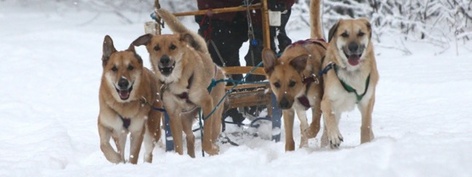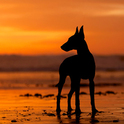Chinook ProjectBreed Coordinator: Karen Hinchy
Scientific Team: Carol Beuchat PhD; Heather Huson PhD, & Pieter Oliehoek PhD (launched September 2012) |
Help us continue the Chinook Project! Thank you for your support!
|
Background

The Chinook was the inspiration of Arthur Treadwell Walden, a sled-dog driver, author, explorer, and innkeeper from the village of Wonalancet, which is nestled at the foot of the White Mountains in north central New Hampshire. Walden created a distinctly tawny, American sled dog that had power, endurance and speed, along with a friendly, gentle nature.
The foundation dogs for the Chinook Breed were descendants of Admiral Peary's Greenland husky lead dog, Polaris, and a mastiff-type farm dog who produced a litter of three pups on January 17, 1917, in New Hampshire. The pups were named Rikki, Tikki, and Tavi after the mongoose in Rudyard Kipling's The Jungle Book. One of these pups was eventually called "Chinook" after a sled dog Walden had used while freighting supplies for gold miners in the Yukon. This dog was the foundation dog of the Chinook breed and is the dog from which all Chinooks have descended.
In 1927, Walden was appointed to head the Dog Department for Admiral Richard Byrd's first Antarctic Expedition (BAE I). Walden and his sixteen Chinook dogs were described by Admiral Byrd as the backbone of the expedition transport.
Over the years, the kennel and its dogs changed hands several times, but the bloodline was carefully guarded and the population never grew very large. By 1965, the Guiness Book of World Records recorded the breed as the world's rarest - with only 125 dogs alive. By the early 1980's the population had dropped to only 11 potentially reproductive dogs. An outcrossing program was attempted to increase genetic heterogeneity, but without a strategic breeding plan it failed to result in much improvement. In the early 1990s several devotees began actively working to revive the breed, and in 2009 it was declared the State Dog of New Hampshire. In 2001 the breed was added to the AKC's Foundation Stock Service, and in 2013 the breed became a full-fledged member of the Working Group.
The breed's historically low population size and a bottleneck that almost resulted in extinction have compromised the gene pool of the breed. Breeders aware of a growing number of health problems have begun an active effort to address these issues. Consequently we have created an independent committee composed of an overwhelming majority of active Chinook breeders along with all owners and members of the Chinook community that are interested in being involved. The Chinook Owners Association (COA; UKC) actively sponsors the work on the project and has included their Registrar and a liaison on the committee. This program is truly a ground-breaking one for the Chinook. As the descendants from the original outcross lines are entering the studbook and the breed is moving into full AKC recognition, the breed is coming to a crossroads. Individuals, breeders, and clubs can and may need to make different decisions about how to move forward in the best interests of the breed. Accurate information on our current population is a critical enabler for all to make the most informed decisions for the future.
We have completed a preliminary analysis of the pedigree database.
GOALS
COMPLETE - 1) Compile global pedigree database back to founders
COMPLETE - 2) Population genetics analysis from pedigree data
COMPLETE - 3) Document the population and genetic history of the breed, including the outcome of the previous outcrossing program;
COMPLETE - 4) Determine current genetic status of the breed: genetic diversity, degree of inbreeding, average kinship, loss of founder alleles, effective population size, contribution of ancestors, etc;
5) Evaluate potential for genetic improvement through strategic breeding of current reproductive individuals, or an outcrossing program if necessary;
6) Design and implement a goal-oriented breeding strategy to improve and sustain genetic health.
7) Establish a permanent, freely accessible, online pedigree database with population genetic statistics and pedigree generation. Integrate pedigree database with health information and DNA/genotyping data.
8) Yearly evaluation of the genetic status of the global breed population and regional subpopulations, adjustment of breeding strategy if necessary, with analysis and reports available online.
9) DNA analysis of the breed to identify the genetic background of the breed (as has been done by Huson for Alaskan sled dogs) and the presence of known canine genetic defects in the gene pool. Genotyping of dogs with extensive information about phenotype of a dog and its relatives will permit establishing estimated breeding values (EBV) that can be used by breeders for more effective selection in breeding programs.
The foundation dogs for the Chinook Breed were descendants of Admiral Peary's Greenland husky lead dog, Polaris, and a mastiff-type farm dog who produced a litter of three pups on January 17, 1917, in New Hampshire. The pups were named Rikki, Tikki, and Tavi after the mongoose in Rudyard Kipling's The Jungle Book. One of these pups was eventually called "Chinook" after a sled dog Walden had used while freighting supplies for gold miners in the Yukon. This dog was the foundation dog of the Chinook breed and is the dog from which all Chinooks have descended.
In 1927, Walden was appointed to head the Dog Department for Admiral Richard Byrd's first Antarctic Expedition (BAE I). Walden and his sixteen Chinook dogs were described by Admiral Byrd as the backbone of the expedition transport.
Over the years, the kennel and its dogs changed hands several times, but the bloodline was carefully guarded and the population never grew very large. By 1965, the Guiness Book of World Records recorded the breed as the world's rarest - with only 125 dogs alive. By the early 1980's the population had dropped to only 11 potentially reproductive dogs. An outcrossing program was attempted to increase genetic heterogeneity, but without a strategic breeding plan it failed to result in much improvement. In the early 1990s several devotees began actively working to revive the breed, and in 2009 it was declared the State Dog of New Hampshire. In 2001 the breed was added to the AKC's Foundation Stock Service, and in 2013 the breed became a full-fledged member of the Working Group.
The breed's historically low population size and a bottleneck that almost resulted in extinction have compromised the gene pool of the breed. Breeders aware of a growing number of health problems have begun an active effort to address these issues. Consequently we have created an independent committee composed of an overwhelming majority of active Chinook breeders along with all owners and members of the Chinook community that are interested in being involved. The Chinook Owners Association (COA; UKC) actively sponsors the work on the project and has included their Registrar and a liaison on the committee. This program is truly a ground-breaking one for the Chinook. As the descendants from the original outcross lines are entering the studbook and the breed is moving into full AKC recognition, the breed is coming to a crossroads. Individuals, breeders, and clubs can and may need to make different decisions about how to move forward in the best interests of the breed. Accurate information on our current population is a critical enabler for all to make the most informed decisions for the future.
We have completed a preliminary analysis of the pedigree database.
GOALS
COMPLETE - 1) Compile global pedigree database back to founders
COMPLETE - 2) Population genetics analysis from pedigree data
COMPLETE - 3) Document the population and genetic history of the breed, including the outcome of the previous outcrossing program;
COMPLETE - 4) Determine current genetic status of the breed: genetic diversity, degree of inbreeding, average kinship, loss of founder alleles, effective population size, contribution of ancestors, etc;
5) Evaluate potential for genetic improvement through strategic breeding of current reproductive individuals, or an outcrossing program if necessary;
6) Design and implement a goal-oriented breeding strategy to improve and sustain genetic health.
7) Establish a permanent, freely accessible, online pedigree database with population genetic statistics and pedigree generation. Integrate pedigree database with health information and DNA/genotyping data.
8) Yearly evaluation of the genetic status of the global breed population and regional subpopulations, adjustment of breeding strategy if necessary, with analysis and reports available online.
9) DNA analysis of the breed to identify the genetic background of the breed (as has been done by Huson for Alaskan sled dogs) and the presence of known canine genetic defects in the gene pool. Genotyping of dogs with extensive information about phenotype of a dog and its relatives will permit establishing estimated breeding values (EBV) that can be used by breeders for more effective selection in breeding programs.

